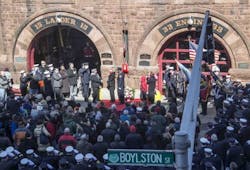Could Higher OSHA Penalties Have Prevented Deadly Boston Fire?
Today (March 26) marks the first anniversary of the Boston Back Bay Fire that killed two Boston firefighters, Lt. Edward Walsh and Firefighter Michael Kennedy.
The fire was caused by sparks from nearby welders working on iron railings on the building next door. The welders were employed with D & J Ironworks; the company hadn’t taken out the required fire department permits, nor was there a firewatch. On that windy day, sparks from the welding ignited the wood clapboard on a shed attached to the building next door, starting the fire. The fierce winds fueled the inferno and the two firefighters were trapped in the basement where they perished; the ultimate sacrifice.
On March 22, the Boston Fire Department honored the fallen firefighters with a memorial plaque at their home Back Bay fire station, Engine 33, Ladder 15.
Investigations Ongoing
The National Institute for Occupational Safety and Health (NIOSH) is completing an investigation that is expected to be finished later this year. The purpose of the report is not to assign blame, but to provide recommendations to ensure tragedies of this type are prevented in the future.
Litigation
According to the Boston Globe1,2, Suffolk County spokesman Jake Wark said the prosecutors are still deciding whether to bring charges in the case; the fact-finding aspect of the investigation is largely complete; applying state statutes and case law to those facts, is under way. The article also noted that civil lawsuits filed against the welding company are pending in Suffolk Superior Court, according to court dockets. One of the suits was filed by the owner of the Back Bay apartment building destroyed by the fire.
OSHA Citations
In September 2014, OSHA issued 10 serious violations to D & J Ironworks with fines totaling $58,000. Three of the citations related to the lack of respirator use, education and documentation and three were related to hazard communication. The other four citations issued received the maximum penalties, and included:
- Not training employees in workplace safety, including fire safety
- No effective fire protection and prevention programs in place
- Welding was not done in a safe location, away from fire hazards during welding and cutting
- Additional fire prevention precautions not taken when normal fire prevention precautions were insufficient, including having a fire watch
Penalties
The maximum penalty allowed for each of the violations is $7,000; there were four that received the maximum penalty and the other six received $5,000 penalties. The fines were reduced to $42,000 and the company is currently on a payment plan.
How Penalties Are Set
The penalties were set by Congress in Section 17 of the Occupational Safety and Health (OSH) Act established in 1970.
In OSHA’s own words, “The penalty structure in Section 17 of the OSH Act is designed primarily to provide an incentive for preventing or correcting violations voluntarily, not only to the cited employer, but to other employers. While penalties are not designed as punishment for violations, Congress has made clear its intent that penalty amounts should be sufficient to serve as an effective deterrent to violations.”
Are Penalties Too Low?
The maximum penalty today for an OSHA serious violation is $7,000, the same as in 1970. Using the Consumer Price Index, the $7,000 penalty, if adjusted for inflation, would be just over $40,000 today. Does it seem that $7,000 would be an effective deterrent to violations, particularly for larger companies? To make it worse, Section 17(j) of the Act provides that penalties can be reduced even further. The following four factors are weighed by OSHA when consideration is given to lowering the penalties: the gravity of the violation; size of the employer’s business; the good faith of the employer; and the employer’s history of previous violations.
Going Forward
Although higher OSHA penalties likely wouldn’t have affected the outcome of the Back Bay tragedy, I believe raising the penalties can serve as a reminder that cutting corners to save money can be expensive if you’re caught, and even more expensive if there’s an incident that could cause (best-case scenario) a business interruption or worst case, injuries and/or deaths.
References:
- Allen, Evan. "Year after Fatal Blaze, Back Bay Firefighters’ Legacy Lives on." Boston Globe. Boston Globe, 20 Mar. 2015. Web. 25 Mar. 2015.
- Cramer, Maria, and John Ellement. "Welding Business Sued Over Fatal Back Bay Fire: Building Owner Says Precautions Lacking in Blaze Tied to Sparks." Boston Globe, 22 Apr. 2014. Web. 25 Mar. 2015.
AMY BEASLEY CRONIN is the wife of a firefighter, and president of Strategic Code Solutions LLC, a consulting firm specializing in code development, training and litigation support. Previously she worked for NFPA for 17 years and was the Manager of Codes and Standards and Secretary to the Standards Council. Amy was also an Officer in the US Public Health Service with the National Institute for Occupational Safety and Health (NIOSH). She has testified before Congress twice and once before the US Chemical Safety Board (CSB) on fire protection advocacy issues. Amy can be reached directly at [email protected].
